Ultimate Guide to the AP U.S. Government and Politics Exam
The AP U.S. Government and Politics exam, more commonly referred to as simply the AP U.S. Government exam (or AP Gov Exam), is one of the harder exams to pass and earn a 5 on. Whether you’ve taken the AP U.S. Government course or decided to self-study for the exam, we’ve put together our expert advice and compiled some of the best resources to help you study. The AP U.S. Government exam is the first AP exam offered in 2020, taking place Monday, May 4, at 8 am. For more information on AP test times, along with advice on registering, study tips, and more, check out our blog post 2020 AP Exam Schedule: Everything You Need to Know. The AP U.S. Government exam measures your understanding of American political culture—in particular, your knowledge of key political concepts, ideas, institutions, policies, interactions, roles, and behaviors that characterize the constitutional system and political culture of the United States. You’ll explore these topics through five disciplinary practices: In addition to the disciplinary practices, students will explore five big ideas that serve as the foundation of the AP U.S. Government course, using them to make connections between concepts throughout the course. The five big ideas are: 1. Constitutionalism: The system of checks and balances—based on law and majority rule and minority rights—between the branches of government and allocation of power between federal and state governments. 2. Liberty and Order: The effects different interpretations of the U.S. constitution have on the laws and policies balancing order and liberty. 3. Civic Participation in Representative Democracy: Considerations such as popular sovereignty, individualism, and republicanism and their effect on U.S. laws and policy. 4. Competition Policy-Making Decisions: Interaction between multiple actors and institutions to produce and implement potential policies. 5. Methods of Political Analysis: The methods political scientists use to measure U.S. political behavior, attitudes, ideologies, and institutions over time. You can check out the College Board website for more information about the exam. The AP U.S Government course is organized into five units. Below is the sequence of the units suggested by the College Board, along with the percentage each unit accounts for on the multiple-choice section of the AP U.S. Government exam. The AP U.S. Government exam lasts three hours and is divided into two sections, multiple choice and free response. Section 1: Multiple Choice 1 hour 20 minutes | 55 questions | 50% of score There are two types of questions in the multiple-choice section—there are about 30 individual questions (with no stimulus) and about 25 questions grouped in sets of two to four questions that respond to the same stimulus. You’ll encounter three different types of questions within the sets: Section 2: Free Response 1 hour 40 minutes | 4 questions | 50% of score The second section of the AP U.S. Government exam contains four free response questions. Students receive 20 minutes to answer the first three free response questions and get 40 minutes to answer the final question. Each question is worth 12.5% of your total score. The four free response questions each test a unique skill. Concept Application: You’re provided with a political scenario and are tasked with explaining the effects of a political institution, behavior, or process. Quantitative Analysis: You’re given quantitative data represented in a table, graph, map, or infographic. You’ll need to identify a trend, pattern, or draw a conclusion and explain its relation to a political principle, institution, process, policy, or behavior. SCOTUS Comparison: You’re given a non-required Supreme Court case and must compare it with a required Supreme Court Case—explaining how the required case is relevant to the non-required one. Argumentation: Develop an argument in essay form using evidence from required foundational documents and course concepts. According to the College Board, 12.9% of students who took the exam in 2019 earned a 5, and 12.4% of students earned a 4. Overall, 55.1% of students who took the AP U.S. Government exam received a “passing” score of 3 or higher. The AP Gov exam is known as one of the harder exams to pass and get a 5 in. For more information about what the AP U.S. Government course is like, check out the course description from the College board website. You should start studying for the AP U.S. Government exam by taking a practice test to assess your current knowledge. The practice test from the College Board offers an excellent starting point. Score your own multiple-choice section and free response, and then ask a teacher or friend to score your free response as well—then, average the two scores since this area is subjective. After you’ve taken your practice test, you can better identify the areas in which you need to improve. Ask the Experts: There are many helpful study guides in this area, including the Princeton Review’s Cracking the AP U.S. Government & Politics Exam 2020, Premium Edition—this offers a very good guide to the exam, although some people criticize it for having too much information. You should think of this study guide as a textbook, rather than a resource to help you cram the night before the test. Barron’s AP U.S. Government and Politics: With 2 Practice Tests has a fantastic reputation as the go-to resource for long-term studying. Find Online Assistance: There are also many online study resources. Some AP teachers post complete study guides or hand out review sheets and test questions as preparation for the exam. You can check out these study guides from mrfarshtey.net and quizlet for more review. Study on-the-go with an app: Apps are also a convenient way to study for AP exams. Just be sure to read the reviews before you purchase one, as you don’t want to end up spending money on an application that isn’t actually effective! Two highly regarded AP U.S. Government and Politics study apps are AP U.S. Government & Politics Exam Prep by Brainscape and AP U.S. Government: Practice Tests and Flashcards by Varsity Tutors. After you’ve determined what your strengths and weaknesses are and have reviewed the theory, you should practice the multiple-choice questions. There are many practice multiple-choice questions available in study guides and online. You’ll also find numerous multiple-choice questions to practice answering in the College Board’s practice tests—2018, 2013, 2012, 2009, and 2005. Be sure to focus on understanding what each question is asking, and keep a running list of any concepts that are still unfamiliar to you. Next, practice the free response questions. Be sure to pay attention to task verbs in questions (words like “describe,” “define,” “discuss,” “explain,” “compare/contrast,” “evaluate/assess,” and “analyze”). Make sure that you understand what each question is asking you to do, and allow this to guide you when answering the free response questions. You should also be extra careful when answering questions that have multiple parts. Underline each section of the question and check them off as you write—students often lose points by forgetting to include a given part of a multipart question. When you’re working through the free response questions, use task verbs in your answer. If you are asked to “give a specific example,” start that part of your answer with “One specific example of this is…” It’s helpful to review free response questions along with scoring and commentary to better understand where students often go wrong or how they might lose points on this section of the exam. The College Board’s website provides the free response questions used on the AP U.S. Government exam dating back to 1999, along with commentary and scoring distributions. After you’ve taken a formative assessment, studied the theory, practiced the multiple-choice section, and worked on your free response writing skills, take another practice exam. Score it the same way as before, and repeat the studying process, making sure to target the areas that are still weak. If you’re taking the AP course associated with this exam, your teacher will walk you through how to register. If you’re self-studying, check out our blog post How to Self-Register for AP Exams. For information about what to bring to the exam, see our post What Should I Bring to My AP Exam (And What Should I Definitely Leave at Home)? CollegeVine can’t solve the mystery of how well you’ll score on the AP U.S. Government exam, but we can take the guesswork out of college admissions. Sign up for your free CollegeVine account to start using our chancing engine today to discover your odds of acceptance at over 500 colleges and universities. Looking for more information on AP exams and courses? If so, check out these other excellent posts: When is the AP AP U.S. Government and Politics Exam?
About the AP U.S. Government and Politics Exam
AP U.S. Government and Politics Course Content
Unit
Percentage of Exam Score (Multiple-Choice Section)
Foundations of American Democracy
15%–22%
Interactions Among Branches of Government
25%–36%
Civil Liberties and Civil Rights
13%–18%
American Political Ideologies and Beliefs
10%–15%
Political Participation
20%–27%
AP U.S. Government and Politics Exam Content
Question Type
Number of Questions
Time Allotted
Percentage of Exam Score
Multiple Choice
55
1 hour 20 minutes
50%
Free Response:
Concept Application
1
20 minutes
12.5%
Free Response: Quantitative Analysis
1
20 minutes
12.5%
Free Response:
SCOTUS Comparison
1
20 minutes
12.5%
Free Response: Argument Essay
1
40 minutes
12.5%
Question Type
Skill Tested
Stimulus
Number of Questions
Quantitative Analysis
Analysis and application of quantitative-based source material.
One or more pieces of quantitative data represented as line graphs, charts, tables, maps, and/or infographics.
Five sets: 2-3 questions per set.
Qualitative Analysis
Analysis and application of text-based (primary and secondary) sources.
One set uses a foundational document, the other includes a primary or secondary text-based source.
Two sets: 3-4 questions per set.
Visual Analysis
Analysis and application of qualitative visual information.
A visual stimulus such as a map, image, cartoon, and/or infographic.
Three sets: 2 questions per set.
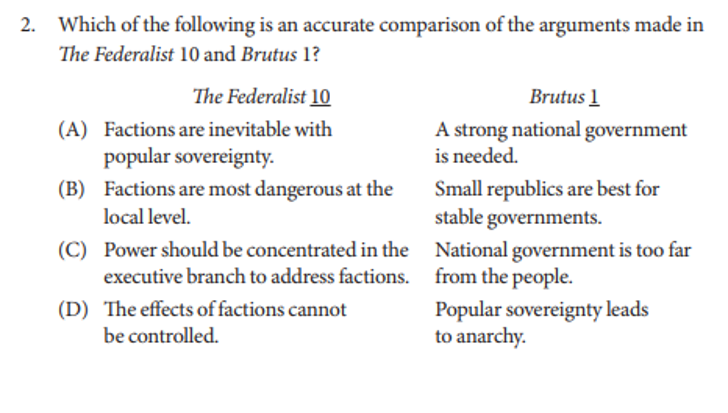
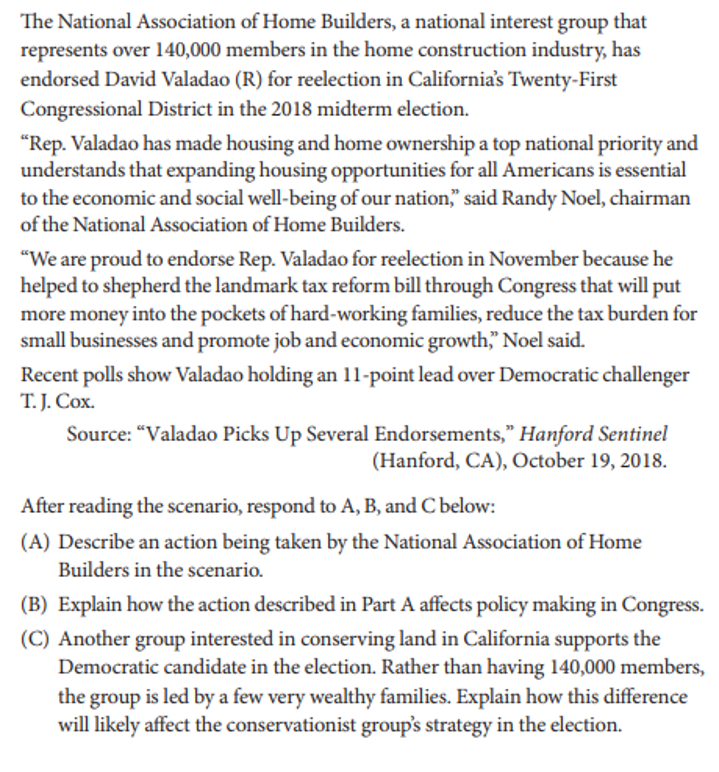
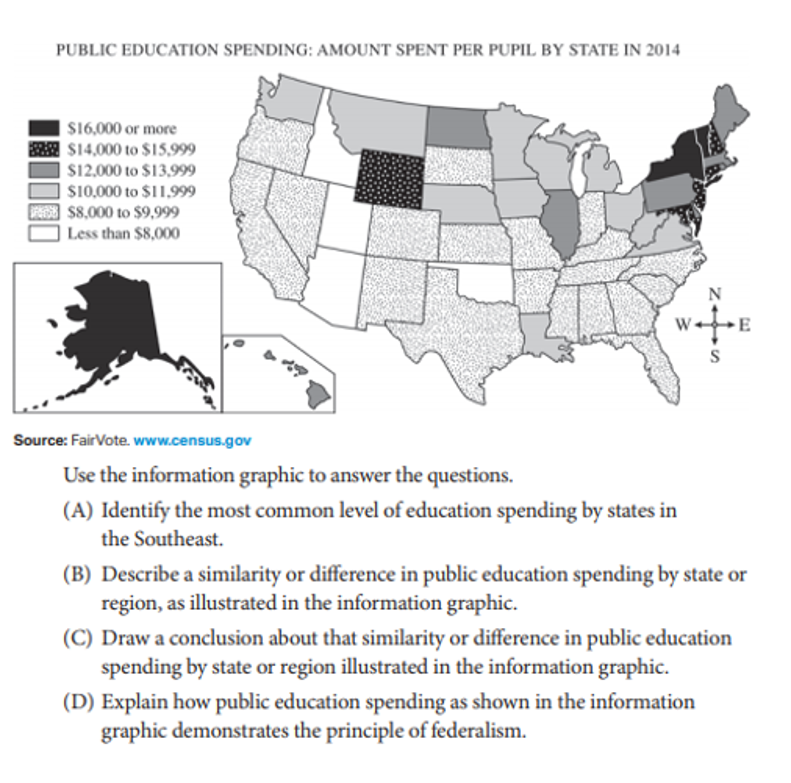
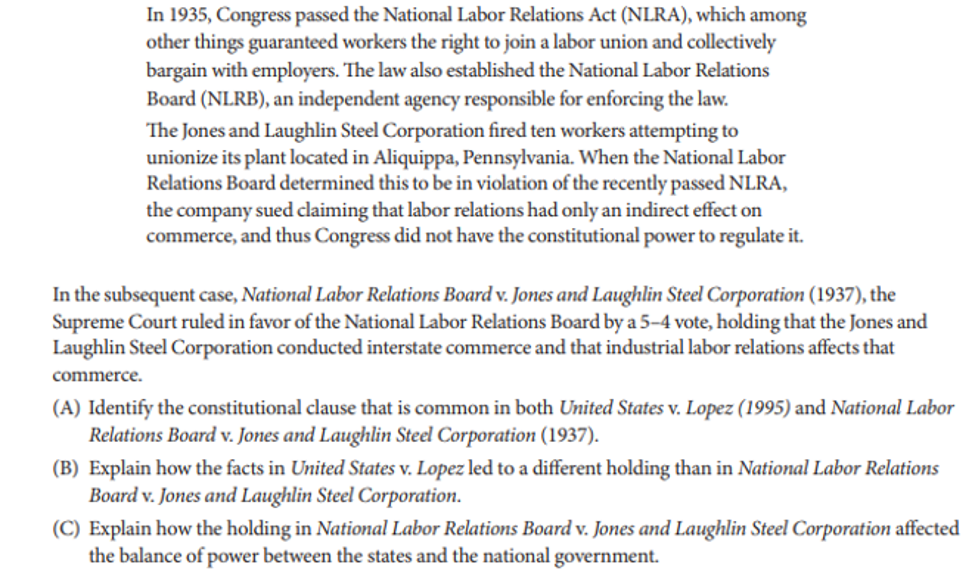
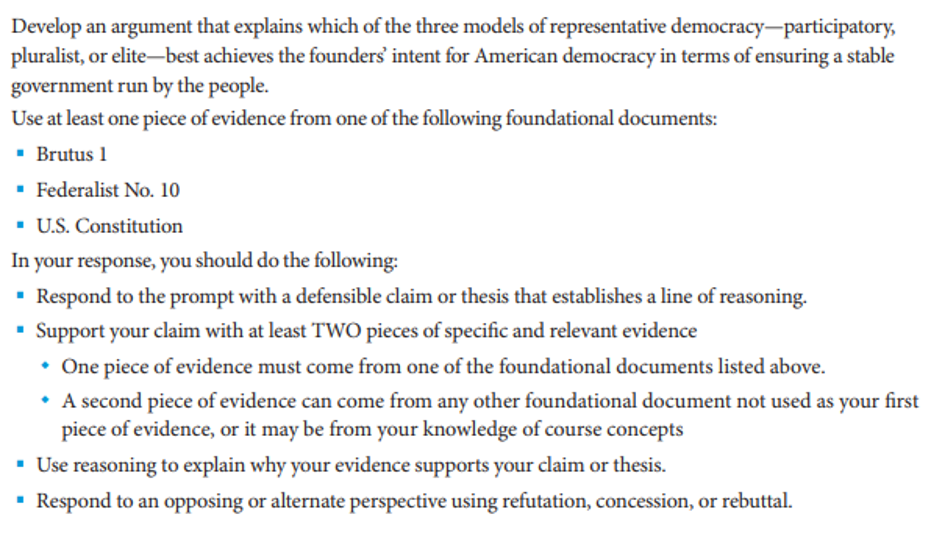
AP U.S. Government Score Distribution, Average Score, and Passing Rate
Exam
5
4
3
2
1
AP U.S. Government
12.9%
12.4%
29.8%
24.8%
20.1%
Best Ways to Study for the AP U.S. Government Exam
Step 1: Assess Your Skills
Step 2: Study the Theory
Step 3: Practice Multiple-Choice Questions
Step 4: Practice Free Response Questions
Step 5: Take Another Practice Exam
Step 6: Exam Day





